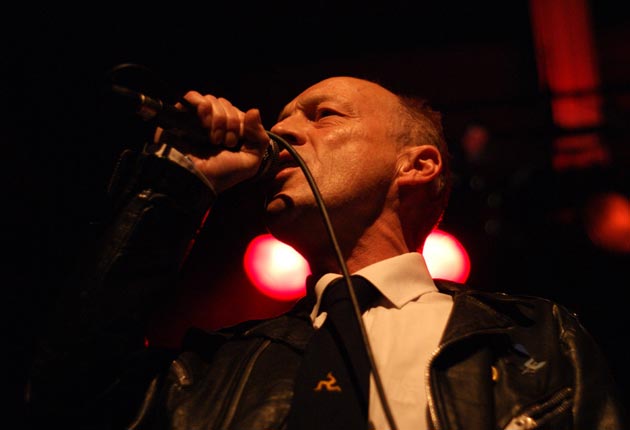Larry Cassidy: Leader of the post-punk Factory group Section 25

Along with Crispy Ambulance and The Wake, the post-punk group Section 25 struggled to emerge from the long shadow cast by their Factory label-mates Joy Division/New Order, in the UK especially, but commanded a strong following in continental Europe, particularly in the Benelux countries and Germany. They recorded a John Peel session in 1981, and supported The Cure, the Stranglers and Talking Heads, as well as several of their Factory contemporaries, and made dark, brooding records which influenced the likes of Sonic Youth and Orbital and were sampled by the Shamen.
I first saw them in February 1980 at the University of London Union on an amazing value-for-money bill also featuring Manchester's jocular power-poppers The Smirks, industrial rock pioneers Killing Joke and the moody, magnificent Joy Division, and still have vivid memories of Section 25's frontman and bassist Larry Cassidy's mesmerising stage presence and his band's then taut, disturbing sound.
Born in Blackpool in 1953, Lawrence John Cassidy assembled and always kept a collection of model aeroplanes, yet chose not to join the family business, Casdon Toys. Instead, he went to London to study law but only lasted a term and switched to fine art and sculpture. He also witnessed the first stirrings of punk at the Roxy in Covent Garden. In the summer of 1977, he returned to Lancashire with a first class arts degree intent on forming a group that would reconcile his love of psychedelia and Krautrock with the vibrancy of punk. Named after a clause in the Mental Health Act allowing for involuntary detention, Section 25 comprised Cassidy on guitar and vocals and his younger brother Vincent – known as Vin – on drums. In 1978, they recruited Paul Wiggin on guitar, and Larry switched to bass as they started gigging around Blackpool and further afield, and began a long association with the Manchester independent Factory.
Their first single, the brittle, bass-driven "Girls Don't Count", was produced by the Joy Division manager Rob Gretton and the band's vocalist Ian Curtis in late 1979, and came in a tracing paper sleeve. Sadly, its release in July 1980 followed the suicide of Curtis two months earlier, and coincided with the posthumous success of Joy Division's "Love Will Tear Us Apart" single and Closer album. Produced by the visionary Martin Hannett and recorded at Pink Floyd's Britannia Row studio in London, Section 25's doomy, dramatic debut album, entitled Always Now, sold 10,000 copies within two weeks in August 1981. Unfortunately, its yellow waxed, marble interior card sleeve shaped like a matchbook, designed by Peter Saville, proved so expensive to manufacture that the band received few royalties. Saville concocted an even more costly floppy-disc-like design for the New Order 12in single "Blue Monday" two years later, which instantly displaced Always Now in Factory lore.
By 1983, Section 25 had released a self-produced second album, The Key Of Dreams, failed to convince Johnny Marr, later of The Smiths, to replace the departing Wiggin, and added Lee Shallcross (percussion), and Larry's future wife Jenny Ross as well as Angela Flowers – the Cassidys' sister under a pseudonym – both on vocals and keyboards. They also rethought their musical direction. "It got boring after three years with the same guys in raincoats coming to our gigs," said Cassidy. "We decided to withdraw and concentrate on writing some new stuff which we could be happy with."
Like fellow their Factory acts A Certain Ratio and New Order, they began exploring the possibilities offered by sequencers and synthesisers and recorded the From The Hip album with Bernard Sumner of New Order and ACR's Donald Johnson producing. Issued in 1984, this eerily potent album and especially the beautiful, bewitching "Looking From A Hilltop" single, featuring Ross on lead vocals, hinted at what was yet to be called acid house, techno and chill-out, and "Hilltop" became a club hit in the US.
In 1985, Section 25 toured there and released "Crazy Wisdom", the last of three singles exclusive to the Factory Benelux operation. However, the group splintered and Larry and Jenny Cassidy completed the Love & Hate album as a duo. Their decision to use "It's Good News Week", the 1965 novelty hit Jonathan King wrote and produced for Hedgehoppers Anonymous, as the starting point for their 1987 single "Bad News Week", backfired when King sued and won 100 per cent of the publishing rights, which further delayed the album.
Cassidy put Section 25 on the shelf and retrained as a teacher. Following Factory's bankruptcy in 1992, their catalogue was re-released by LTM, along with a DVD and previously unavailable live and studio recordings.
Section 25 returned in 2001 but Jenny's death three years later proved the toughest of all setbacks. It was a measure of Cassidy's drive and determination that he began gigging again in 2006, and took part in the Factory documentary Shadowplayers with Vin. They made two new studio albums, Part-Primitiv in 2007, and Nature + Degree in 2009 – featuring Larry's daughter Bethany on vocals – and enjoyed some of their best reviews for their concerts with the New Order bassist Peter Hook two years ago.
Last September, the reactivated Section 25 played in Rochdale to celebrate the unveiling of a blue plaque at the site of the legendary Cargo studios where they had followed The Fall, Joy Division and OMD and recorded their debut single. According to reports, Cassidy was less grumpy than usual, yet as compelling a performer as ever.
Pierre Perrone
Lawrence John Cassidy, singer, musician, songwriter: born Blackpool 18 April 1953; married Jenny Ross (died 2004; one son, one daughter); died Blackpool 27 February 2010.
Subscribe to Independent Premium to bookmark this article
Want to bookmark your favourite articles and stories to read or reference later? Start your Independent Premium subscription today.

Join our commenting forum
Join thought-provoking conversations, follow other Independent readers and see their replies